The Ultimate Guide to Cleaning and Maintaining Your Pellet Stove
- November 13, 2023
- 0 comment
Pellet stoves, recognized by the U.S. Department of Energy as the cleanest residential heating appliances using solid fuel, offer an eco-friendly and efficient way to heat your home. Whether freestanding or as a fireplace insert, understanding the maintenance and cleaning of your pellet stove is crucial for its optimal performance.
What is a Pellet Stove?
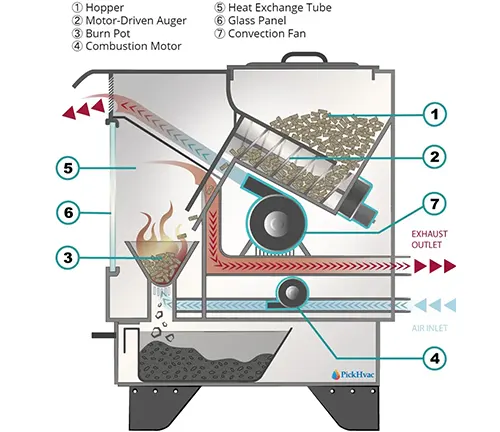
A pellet stove is a modern heating appliance that utilizes compressed natural particles as fuel. These particles can be made from a variety of materials, including wood, nutshells, corn kernels, or small wood chips. The key to its operation lies in the pellets themselves, which are densely packed and offer a high energy output with minimal waste.
The stove operates with an electrically powered auger that meticulously feeds these pellets from a storage hopper into the combustion chamber. This methodical feeding process is crucial as it controls the rate at which the pellets are burned, thus regulating the heat output. The speed and quantity of pellets feeding into the combustion chamber depend on two primary factors: the temperature set by the user and the stove’s inherent efficiency.
One of the standout features of pellet stoves is their efficiency in burning. Unlike traditional wood stoves, pellet stoves are capable of achieving a more complete burn, resulting in less ash and higher heat output. This efficiency is partly due to the controlled manner in which the fuel is delivered and burned, as well as the design of the stove which typically includes a ventilation system to ensure adequate air flow for combustion.
The Importance of Regular Maintenance
Regular maintenance is essential to maintain the efficiency of the stove, prevent safety hazards, and ensure the desired heat output. Neglect can lead to lower burning efficiency, potential safety risks like chimney fires, and external staining.
Basic Stove Cleaning (Bi-Weekly)
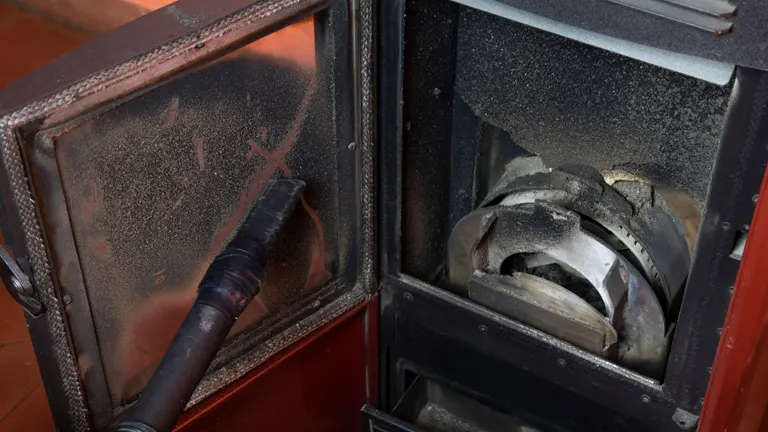
To maintain your stove’s functionality, perform the following bi-weekly:
- Ash Removal: For maintaining your stove’s efficiency, it’s crucial to regularly remove ash. Every two weeks, use an ash vacuum to clean out the burn box and firebox. An ash vacuum is specifically designed to safely and effectively remove fine ash particles, preventing them from dispersing into your living space.
- Carbon Deposit Removal: Carbon deposits can accumulate and impede your stove’s performance. Bi-weekly, use the cleaning tool provided with your stove to gently scrape away these deposits. Ensure to use tools specifically designed for your stove to avoid damaging its components.
- Heat Exchanger Cleaning: The heat exchanger should be cleaned bi-weekly to ensure efficient heat transfer. Most stoves feature a lever for easy cleaning of the exchanger. In cases of stubborn carbon deposits, a wire brush can be employed for a more thorough cleaning.
- Firebox Vacuuming: Following the removal of carbon deposits, vacuum the firebox again to eliminate any remaining ash. This step is vital for maintaining your stove’s operational efficiency and safety, as it minimizes the risk of potential fire hazards.
- Glass Cleaning: Regular cleaning of the stove’s glass allows you to enjoy the visual appeal of the flames. Use a cleaner specifically approved for stove glass to avoid any damage. Apply the cleaner on a soft cloth and gently wipe the glass to maintain clarity and cleanliness.
Tip: Use High-Quality Pellets
Using high-quality pellets, such as Lignetics Wood Pellets, is recommended for optimal stove performance. These pellets burn more efficiently and produce less ash and soot, thereby reducing the need for frequent and intensive cleaning. Select pellets with low moisture content and minimal fillers for a cleaner, more efficient burn.
Monthly Stove Cleaning

Monthly tasks include:
- Blower Motor and Fan Cleaning: Monthly cleaning of the blower motor and fan is essential to maintain your pellet stove’s efficiency. Use a small paintbrush to gently dislodge any dust or debris that has accumulated on these components. Follow up with a vacuum to remove the loosened particles. This process ensures that the blower motor and fan operate smoothly, which is crucial for effective heat distribution and stove performance.
- Gasket Inspection: It’s important to inspect and clean the gaskets around the stove’s door and hopper lid every month. Check for any signs of wear, damage, or residue buildup. If the gaskets are in poor condition, they should be replaced to ensure an airtight seal. Properly functioning gaskets are vital for maintaining the efficiency of your stove and preventing any heat loss or smoke leakage.
Annual Pellet Stove Cleaning
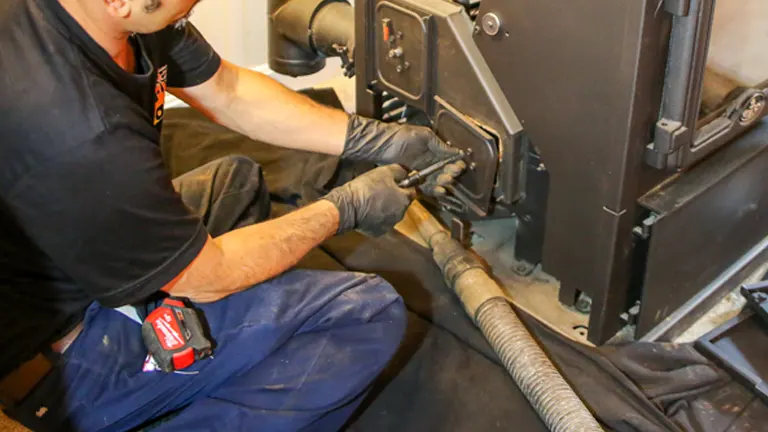
Conduct a thorough cleaning at the year’s end:
- Annual Pellet Stove Cleaning: Annual cleaning is crucial for the longevity and optimal performance of your pellet stove. As the year draws to a close, it’s time to give your stove a comprehensive cleaning:
- Complete Pellet Removal: Begin your annual maintenance by completely emptying all the pellets from the stove. This step is essential to ensure you can clean every part of the stove thoroughly without any obstructions.
- Comprehensive Vacuuming: Once the pellets are removed, vacuum out all the debris and ash from every part of the stove. This includes the combustion chamber, ash traps, and any other areas where ash and soot may accumulate over time.
- Component Inspection: Carefully inspect the hopper, auger plate, and all switches for any signs of debris accumulation, wear, or damage. This inspection is crucial to identify any parts that may need repair or replacement to ensure your stove operates safely and efficiently.
- Chimney and Vent Cleaning: Thoroughly clean the chimney and exhaust vent. This often involves vacuuming out the chimney and venting system to remove any soot, ash, or blockages. Proper chimney and vent maintenance is vital for ensuring safe and efficient stove operation.
- Blower and Auger Maintenance: The combustion and convection blowers, as well as the auger motor, should be cleaned and lubricated. This maintenance helps ensure these components run smoothly, which is essential for the efficient and effective operation of your stove.
- Electrical Check: Perform a detailed inspection of all electrical wiring, heat switches, and sensors. This step is crucial for ensuring the electrical components of your stove are in good condition and functioning correctly, which is essential for safe operation.
- Operational Test: After completing all the cleaning and maintenance tasks, start the stove to ensure everything is functioning properly. This operational test helps to confirm that all components are working correctly and the stove is ready for efficient operation in the coming year.
Tips and Warnings for Cleaning Your Pellet Stove
Tips:
- When cleaning out ash, use a HEPA filter vacuum or a specialized ash vacuum. These are designed to handle fine ash particles safely and prevent them from spreading into the air.
- For better efficiency and less soot buildup, opt for high-quality pellets. These pellets burn cleaner, reducing the frequency and intensity of cleaning required.
- Don’t overlook the exterior of your stove. A clean exterior not only enhances the appearance of your stove but also allows you to inspect for any potential external issues.
Warnings:
- For safety, always unplug your pellet stove before starting any cleaning procedure. This precaution prevents any electrical hazards.
- Ensure the stove has cooled down completely before you begin cleaning. Cleaning a hot stove can be dangerous and may cause burns or other injuries.
By following these tips and heeding these warnings, you can effectively maintain your pellet stove, ensuring it operates safely and efficiently for years to come.
Why Maintenance Matters
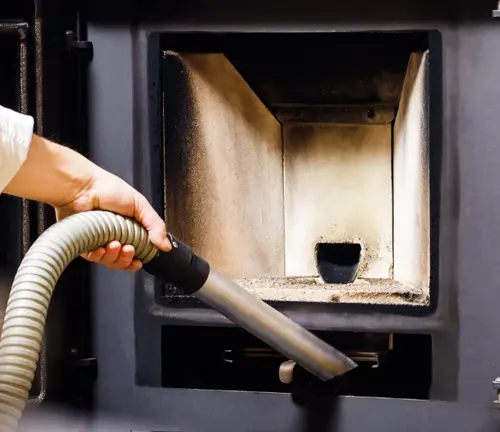
Regular maintenance of your pellet stove is not just a matter of efficiency, but also of safety and longevity. Consistent upkeep ensures that the stove operates at its optimal level, maintaining the desired heat output and energy efficiency. It prevents the buildup of soot and ash, which can hinder performance and lead to potential safety hazards like chimney fires or carbon monoxide leaks. Moreover, regular maintenance checks can identify and rectify minor issues before they escalate into major problems, potentially saving you from costly repairs in the long run. In essence, routine maintenance is key to ensuring that your pellet stove remains a reliable, effective, and safe heating source for your home.
Conclusion
In conclusion, the diligent maintenance of your pellet stove is integral to its longevity, efficiency, and overall performance. By adhering to the outlined cleaning and maintenance routines – be it bi-weekly, monthly, or annually – you not only ensure the smooth operation of your stove but also significantly extend its lifespan. This proactive approach to upkeep not only enhances the warmth and comfort of your home during the winter months but also ensures a safe and cost-effective heating solution. Remember, a well-maintained pellet stove is more than just a heating appliance; it’s a long-term investment in the cozy and energy-efficient ambiance of your home.
We Want to Hear From You!
Your experiences and insights are invaluable to us and our community of readers. Do you have any tips or stories about maintaining your pellet stove? Have you encountered a unique challenge or discovered an effective solution? Please share your thoughts and experiences in the comments below. Your contributions not only enrich our knowledge but also help others in their journey to efficient and safe pellet stove ownership. Let’s keep the conversation going – comment, share, and be part of a community dedicated to smart and sustainable living!
Related Articles:
- How to Get Wood Stove Heat to Other Rooms: A Comprehensive Guide
- Best Pellet Stoves of 2023
- Can You Burn Pellets In A Wood Stove?
- Wood Stove vs Pellet Stove 2023
FAQs
- Can I use a regular vacuum instead of an ash vacuum for cleaning my pellet stove?
It’s not recommended to use a regular vacuum for cleaning a pellet stove because they are not designed to handle fine ash particles. Ash vacuums are specifically built to safely manage ash without clogging or spreading ash into the air. - How often should I replace the gaskets in my pellet stove?
The frequency of gasket replacement depends on usage and the model of your stove, but a general rule is to inspect them annually and replace them if you notice wear and tear, or every 2-3 years as a preventative measure. - Can I burn other materials like paper or cardboard in my pellet stove?
It is not advisable to burn anything other than the manufacturer-recommended pellets in your pellet stove. Burning inappropriate materials can cause damage to the stove, create hazardous conditions, and void your warranty. - Is it safe to clean the stove’s electrical components myself?
Cleaning electrical components can be risky and should generally be left to professionals or done according to the manufacturer’s instructions. Always unplug the stove before attempting any cleaning or maintenance. - What should I do if my pellet stove is producing a lot of smoke?
Excessive smoke might indicate poor ventilation, clogged exhaust, or the use of low-quality pellets. Ensure your venting system is clear and consider switching to higher-grade pellets. If the problem persists, consult a professional. - How can I tell if my auger is not working properly?
Common signs of auger issues include unusual noises, difficulty feeding pellets into the burn pot, or the stove not lighting. It may require cleaning, lubrication, or professional servicing. - Does the quality of pellets really affect the stove’s performance?
Absolutely. Higher-quality pellets burn more efficiently and produce less ash, which means less frequent cleaning and better overall performance of your stove. - What’s the best way to clean the glass on my pellet stove?
Use a soft cloth and a cleaner specifically designed for stove glass. Avoid abrasive materials that can scratch the glass. For a homemade solution, you can use vinegar or a paste made from ash and water.

David Murray
Forestry AuthorI'm David Murry, a forestry equipment specialist with a focus on chainsaw operation. With over 13 years of experience, I've honed my skills in operating and maintaining a wide range of machinery, from chainsaws to log splitters. My passion for the outdoors and commitment to sustainable forestry drive my work, which emphasizes safety, efficiency, and staying updated with industry advancements. Additionally, I'm dedicated to sharing my expertise and promoting environmental awareness within the forestry community.

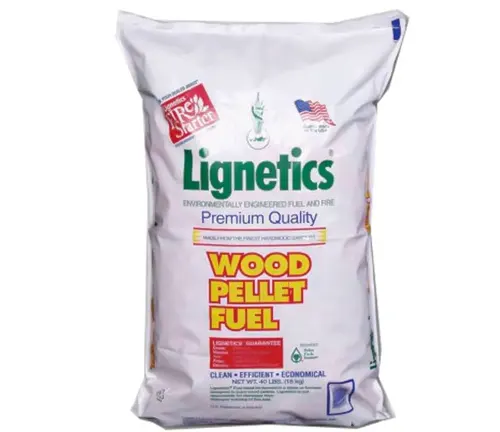

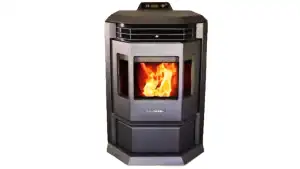


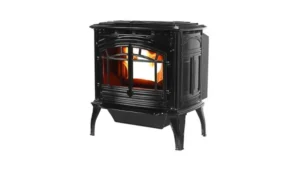



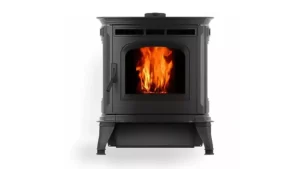
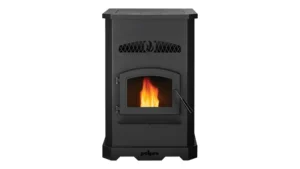
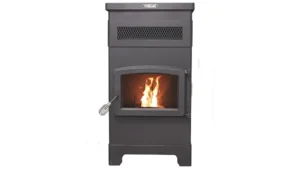

Leave your comment